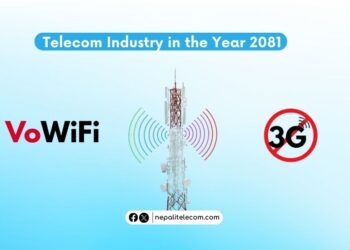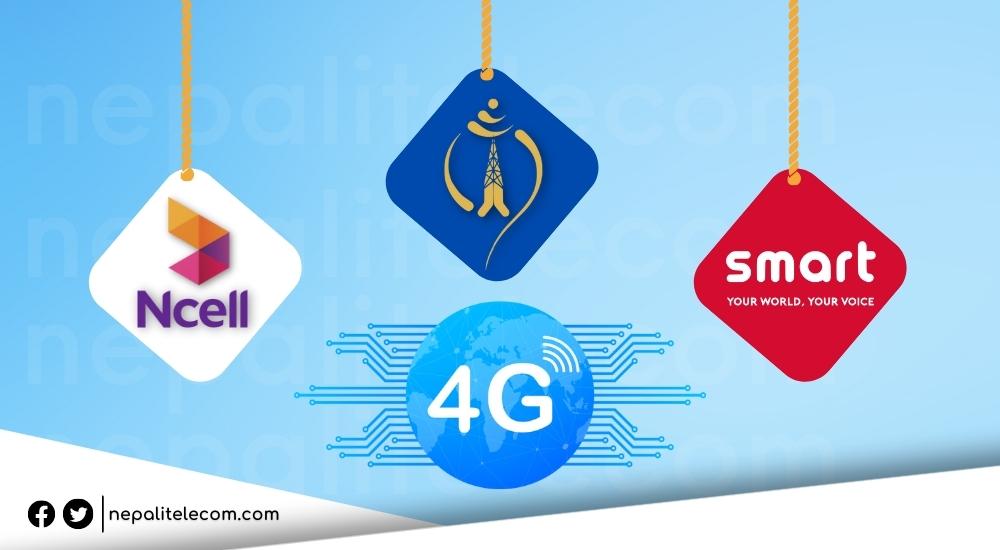International Telecommunication Union (ITU), the umbrella body that is responsible for matters related to ICT has released its 2023 report of Facts and Figures detailing the status of digital connectivity around the world. As per this latest report which reveals figures from 2023, 5.4 billion people were online, that’s 67% of the entire world’s population. At the same time, 5G coverage has reached 40% global population. The same report also highlights how broadband connectivity is becoming more affordable contributing to bridging the digital divide across the states. Here, we present all the comprehensive details on how the status of global internet connectivity fared in 2023, as per the ITU report 2023 on internet connectivity.
Check out: 5G network in Nepal; Spectrum, Latest Update
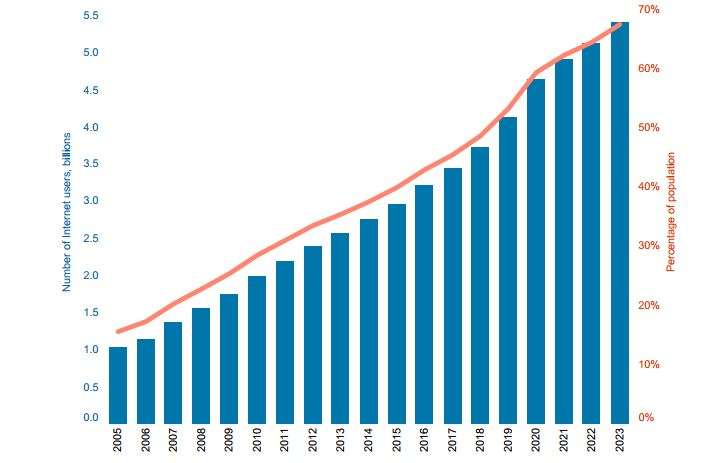
About 5.4 billion people are now online which is 67% percent of the entire world’s population. This means the number of people being “offline” declined to 2.6 billion (33% of the global population). It marks a 4.7% growth since 2022 and an increase of 3.5% from 2021 to 2022.
Internet coverage among high-income states
Breaking down the details, ITU found that 93% of the people in high-income countries were connected to the Internet. This figure almost represents the ‘universality’ that the union holds. The figure contrasts with nine out of 10 people being online in 2020.
Internet coverage among low-income states
In low-income countries, the percentage of internet-using people was 27% increasing from 24% in 2022. What’s so disheartening is that there is a gulf of 66% in the status of internet use between the high-income and low-income countries reflecting that a loss is yet to be done to bridge the digital divide that persists between the two types of nations around the world.
Anyway, the data continues to improve. In low-income countries, internet users have grown by an enthralling 44.1% since 2020 and by 14.3% from 2022. This shall increase further and more dramatically as connectivity continues to form a core priority across the global states.
But there is one interesting aspect to take into account. No matter how connectivity grows, it seems almost unlikely that the connected population will reach 100% even in high-income countries. The number of internet users increased by just 1.1%, understandable as the internet penetration already stands at 93%. But some people will never want to get connected. We recommend you to read our post on digital detox.
Internet connectivity in least-developed countries (LDCs)
In least-developed countries and landlocked countries, the connectivity leaves far more to be fulfilled. In LDCs and LLDCs, only 35% and 39% population are connected to the Internet respectively.
Internet connectivity among the gender
Globally, it’s found that 70% of men are using the internet compared to 65% of women. That means 244 million more men were using the internet in 2023. This is not a large gulf as seen between the low-income and high-income countries. However, the connectivity figures are also determined by the socioeconomic factors of the countries.
Currently, the share of women using the internet by the share of men using the same stands between 0.98 to 1.02. The score has improved from 0.90 in 2019 to 0.92 in 2023. But broadly speaking, in terms of population, women outnumber male offline users by 17% increasing from 11% in 2023.
You may also want to read: Internet Access Reaches 37.8 Percent in Nepal, 17 Lakhs Without a Smartphone as per the National Census 2078 Report
Gender parity of Internet users in the Americas, APAC, and others
The gender parity score is almost perfect in the Americas, the CIS, and Europe. The Asia-Pacific (APAC) score has surpassed 0.9 mark. In the meantime, the Arab Stages region has reflected the strongest progress with the score improving from 0.79 in 2019 to 0.87 in 2023.
Africa shows wide gender disparity in internet access
While many regions are showing progress in internet accessibility, Africa leaves a lot to be done. In 2023, ITU found that still four in ten men used the internet. Starkly, just three in ten women were connected online in the same year. Among the countries, the LDCs continue to lag behind high-income countries in internet access despite making some progress in recent years. Small island countries where two-thirds of the population use the internet fared better in gender parity. In 2019, the share of women using the internet was higher than men’s score of 1.02.
Internet connectivity in cities in 2023
As expected, the number of people in cities using the Internet increased In 2023. As per the report, 81% of urban dwellers used the internet in 2023 while only 50% of those living in rural areas went online. This urban-rural gap hasn’t improved in recent years. The stat slightly bettered from 1.7 in 2020 to 1.6 in 2023.
Speaking of the urban-rural internet disparity, there’s almost none in Europe. The ratio is 1.2 in both North and South America and the CIS regions. In Asia-Pacific, the urban-rural internet connectivity gap is 1.5. Africa shows the worst gap with 57% of urban dwellers using the internet while only 23% living in the villages were online in 2023.
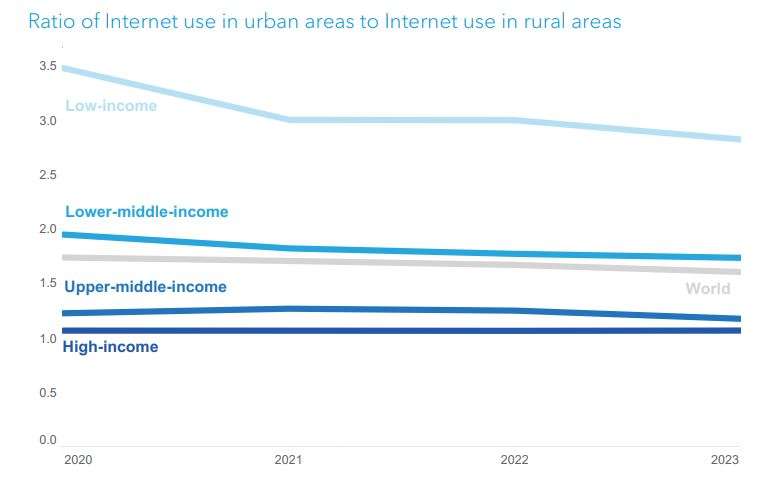
Just like in Europe, the gap has been almost bridged in high-income countries at a ratio of 1.1. In low-income countries, less than one in five people in rural areas use the internet in cities.
The broadband connection grows while fixed telephone sees further decline
Mobile broadband subscription continues to mark noticeable growth. As of 2023, there are 111 mobile-cellular subscriptions and 87 mobile-broadband subscriptions per 100 inhabitants. In the last five years, mobile broadband subscriptions grew by 27%, four times the rate for mobile-cellular subscriptions (7%).
Fixed-broadband subscriptions have also grown steadily, at an average rate of 6.7% per year. But with a high time of mobile use, fixed-telephone subscriptions continue their sharp fall. Since 2005, fixed-telephone coverage has dropped by half, from 20 subscriptions to 11 subscriptions per 100 inhabitants.
Check out: Ncell eSIM Upgrade; How to activate?
Broadband continues to be more affordable
The ITU report 2023 mentions that fixed- and mobile broadband became more affordable in 2023. The two connectivity benchmarks, namely the “data-only mobile-broadband basket” and the “fixed-broadband basket”, have become cheaper across the world. The global median price of the mobile broadband basket dropped from 1.5 to 1.3% of gross national income (GNI) per capita. Likewise, the same fixed-broadband basket dropped from 3.2 to 2.9% of GNI per capita. However, lack of affordability remains a key hurdle to internet access in low-income countries.
Also, there tends to be a wide gap between high-income countries and the rest of the world. Compared to costs in high-income economies, the mobile-broadband basket is 5.5 times less affordable in lower-middle-income economies and more than 20 times less affordable in low-income economies, where a fixed-broadband subscription, costs the equivalent of a third of the average monthly income.
The United Nations Broadband Commission for Sustainable Development has aimed to make broadband services more affordable for low-income countries by 2025.
On mobile phone ownership
The data shows that more people own a mobile phone than those who use the internet. In all the regions, 78% of the population aged 10 and over in 2023 own a mobile phone, 11 percentage points higher than the percentage of individuals who use the Internet. The trend shows that this gap is thinning in all regions. The growth in internet use has outpaced the growth of mobile phone ownership in the last three years.
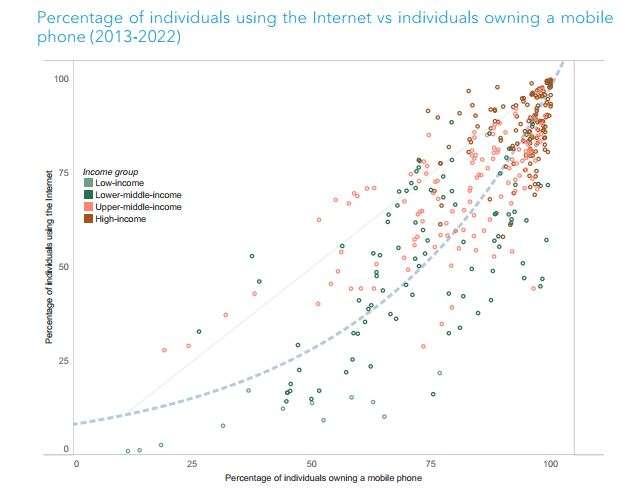
In the Americas, CIS, and Europe, the rate of mobile phone ownership is less than five percentage points higher than Internet use. The internet access in these countries is at 80%. The gap is 9 percentage points in the Asia-Pacific and 14 percentage points in the Arab States region. In the African region, where 63% of the population own a mobile phone but only 37% use the Internet, the gap is 26 percentage points.
Check out: How to track/report lost/stolen mobile phones?
Older networks getting switched off
With the advent and growing proliferation of 5G networks, legacy networks are being completely switched off. Most European countries plan to switch off 3G networks by December 2025 and so is the case for most in the APAC region. However, the same cannot be stated for many other countries too as they lack a clear roadmap for mobile connectivity. In these countries, 2G and 3G still constitute the major drivers for cellular connectivity. These countries face difficulty in switching to 5G because of the high cost of infrastructure, device affordability, and regulatory hassles.
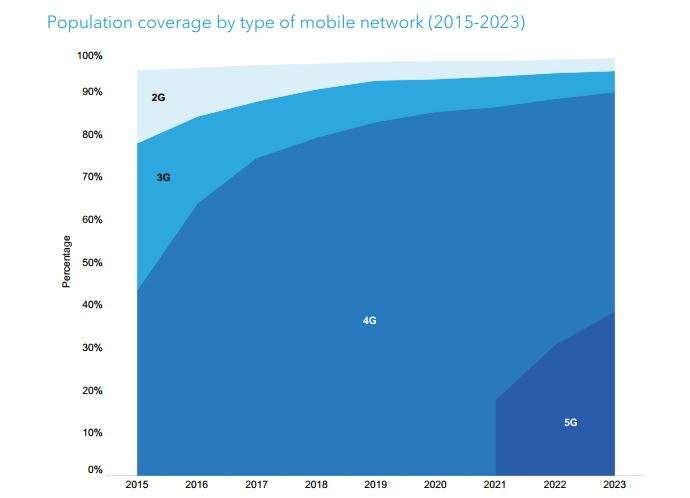
Since 2019 when commercial 5G deployment began, 40% of the world population has been privileged with this network as of 2023. But the distribution remains incredibly uneven. Of all, 89% of the population in the high-income countries has access to 5G. It’s limited to low-income countries. At the same time, Europe boasts the most extensive 5G coverage with 98% population covered by the extremely high-speed network. In Arab States region, the figure is 12%, and less than 10% in the CIS region. Only 6% population in Africa has access to 5G.
5G network now covers 40% of the world population but with huge discrepancy in distribution- ITU report 2023
Also read: 2G or 3G? Which Mobile Network Will Shut Down in Nepal?
90% of the world has 4G
The ITU report has it that as of 2023, 90% of the world population secured access to 4G. So, it’s a very good alternative where 5G continues to be elusive. However, 55% of people in low-income countries have no access to this either. In high-income and middle-income countries, 95% of people have 4G network access compared to 39% in low-income countries where 3G remains dominant.
Also read: Total 4G users of Nepal with latest figures of NTC and Ncell
Internet traffic
The global mobile-broadband traffic rates reached 913 exabytes (EB) in 2022, double the traffic of 419 EB in 2019. Between 2019 and 2023, mobile- and fixed-broadband traffic has reached an annual average growth of 30%. The peak traffic was recorded at the start of the COVID-19 pandemic in 2020. Since then, the post-pandemic traffic growth slowed between 2021 and 2022. During this period, mobile broadband traffic increased by 22%, and fixed broadband increased by 10%. Fixed broadband remains the default choice for “heavy Internet data usage”. In 2022, the mobile broadband share of traffic had increased from 3.4 to 4.2%.
In 2022, fixed-broadband traffic per user (subscription) reached 257 gigabytes (GB) on a monthly average worldwide, in contrast to the mobile-broadband traffic per subscription average of 11 GB. The average annual increase of fixed-broadband traffic per subscription stood at 21% over the 2019 to 2022 period. This figure witnessed a remarkable slowdown in growth, marking an increase of just 3% from 2021 to 2022.
Also read: Nepal’s Per Month Smartphone Mobile Data Traffic to Increase by 2.2 Times- GSMA Predicts
However, after network infrastructure upgrades, the deployment of 5G networks, and increasing demand, mobile-broadband traffic per subscription increased by 26% per year every year from 2019 to 2021. The trend grew by another 17% from 2021 to 2022.
Broadband traffic generation differences
There are some significant regional differences in mobile- and fixed-broadband traffic per subscription. In North and South America, a fixed-broadband subscription generates 326 GB of traffic a month. In Africa, the figure compares with 130 GB per month. There is a wider gulf in mobile broadband traffic numbers. In Africa, the monthly mobile broadband traffic average per subscription was 1.9 GB, six times less than the world average of 11.2 GB and eight times less than the CIS region average (15.1 GB).
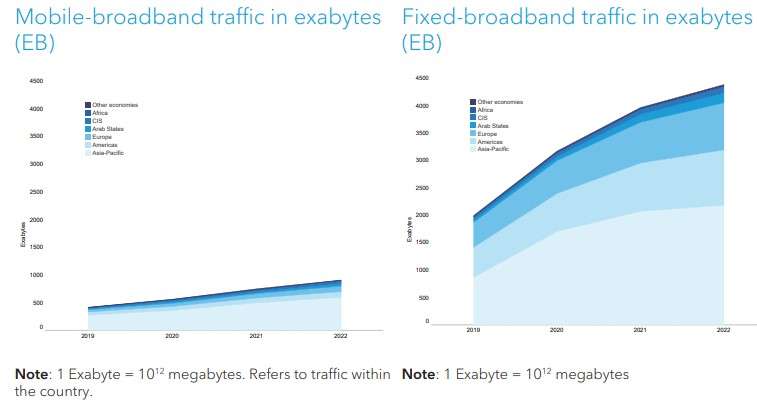
The income levels also reflect contrasting internet traffic generation. The fixed-broadband subscription rises with increases in income levels. In low-income countries, the fixed-broadband subscription traffic stood at 161 GB per subscription while it was 347 GB per subscription in high-income countries.
For mobile broadband, both middle- and high-income countries generate very similar traffic averages, from about 10 to 12 GB a month. This shows an almost ten-fold difference with low-income economies whose data record 1.3 GB of traffic per month.
How do you find the ITU report for the state of internet connectivity globally in 2023? Do let us know about the use of internet connectivity in your daily life and how has the connectivity helped you. Do you think the communication services are doing enough to bridge the digital divide in Nepal? Offer your honest input on this topic in the comments below.





